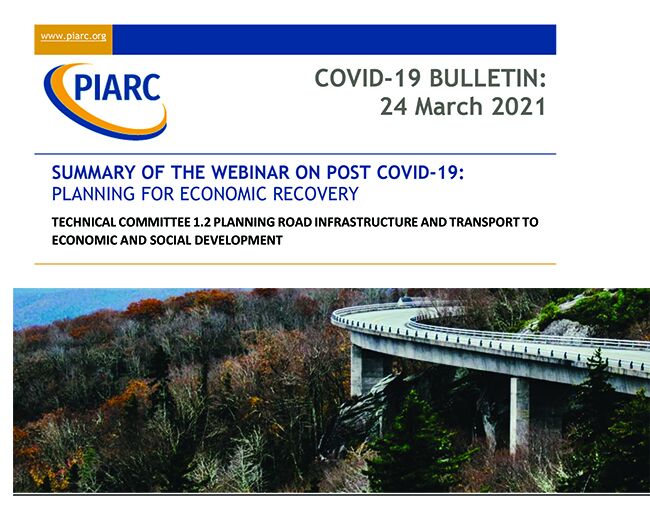Summary of the Webinar on Post Covid-19: Planning for Economic Recovery - Briefing Note

This Bulletin has been prepared by Technical Committee 1.2 on “Planning Road Infrastructure and Transport to Economic and Social Development” of PIARC (the World Road Association).
The COVID-19 pandemic has accelerated key trends that directly affect transportation and is presenting transportation and transportation planners with an unprecedented set of new challenges and possibilities.
This event is unique from past economic downturns because of its scope and scale literally touches all sectors of the economy.It is also notable for how the response to restrictions, such as social distancing, have led transportation planners to think about how we live, work, and travel.For example, it appears that there is more awareness of our values regarding health, human interactions, and the environment.
It is clear now that all of us in the transportation industry are currently and will continue to be challenged to consider the role of transportation in an evolving “new normal” that includes differing views on personal, economic, and societal priorities.
It is also clear that the pandemic and associated mitigation policies are affecting travel behavior as well as attitudes. For example, transportation planners are seeing changes that include significant shifts in transportation demand, supply, and performance. While it is impossible for Transportation Planners to forecast which of these changes will stick, approaches to planning transportation systems and investments must be evaluated and transformed.Furthermore, Transportation Planners will certainly need to expand their engagement to be inclusive of human service, economic development, and health organizations to understand how the “new normal” for transportation may evolve.
Members of the PIARC Tech 1.2 – Work Group-B (WG-B) are working during this cycle to identify, investigate, then document the emerging methods, practices, and guidelines for determining the Economic and social contribution of road transport systems.
While the WG-B efforts are focused primarily on non-pandemic case study, we recognize that changes associated with the Pandemic will require immediate planning, prioritization, and implementation to adapt to post-COVID-19 Recovery.
As such, presenters offered examples that are intended to inform webinar participant’s understanding of- and assist planning for post-COVID-19 recovery including tools, methods, and processes for evaluating a spectrum of possible future post-COVID-19 Recovery scenarios to assist transportation planner ability to pivot swiftly and respond to future change.WG-B’s hope is that this webinar assists transportation planners to confidently determine the best path to assess, address, and manage the economic and social needs & impacts of the post-pandemic world!
This Bulletin summarizes the Webinar held on March 24, 2021.This PIARC COVID Webinar provided a useful global platform to share relevant information and practices from around the world on pandemic impacts and responses for the road and transport community, and to assist practitioners in identifying plans for post-COVID-19 economic recovery appropriate for their respective situations.
Information sheet
- Date: 2022
- Author(s): PIARC COVID Response Team / Equipe de réponse COVID de PIARC / Equipo de respuesta COVID de PIARC
- Type: Briefing Note
- PIARC Ref.: 2022R15EN
- ISBN: 978-2-84060-690-1
- Number of pages: 17